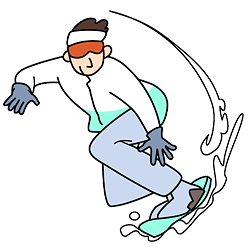(1) The general public do not feel that the word is a load word since the history of the usage is old. This type of Gairaigo has
already harmonized with the Japanese language.
ex. タバコ (tabako)、 カッパ (rain jacket)
(2) The general public keep the feeling of foreign language.
ex. オーソリティ (authority)、フィアンセ (fiansé)
(3) the word which is in between (1) and (2)
1. adopts the fixed usage
2. adopts the simple transcription which is based on an audible sound as an origianal language
The following rules are quoted from the report of National Language Council in Japan (1954). Some of examples are omitted/added.
(1) Gairaigo is written in Katakana.
(2) The fixed usage is followed by it's present usage.
(3) Syllabic nasal is written 「ン」. ex. テンポ (tempo)、トランク (trunk)
(4) Geminate consonant is written 「ッ」 (small "tsu"). ex, コップ (glass)、 カップ (cup)、カット (cut)
(5) In traditional way such as アクセッサリー(accessories)、コンミュニケ(communiqué) omit 「ッ」 and 「ン」.
exc. シャッター (shutter)、バッター (batter)
(6) Palatalized syllable is written small "ya, yu, yo". ex. ジャズ (jazz)、 チョーク (chalk)
(7) Long vowel is written by a mark, 「-」. That is not written by the addition of vowel or 「ウ」
× ボウル(ball)、ボオル(ball)、オウトバイ(motorcycle) 、オオトバイ (motorcycle)
○ ボール、オートバイ
「エイ」 and 「オウ」("ei" and "ou") is considered long vowel.
ex. ショー (show)、メーデー (May Day) exc. エイト (eight)、ペイント(paint)
* It is important not to confuse Romanization and Katakana writing. 「えいご」 in Hiragana writing is "eigo/eego/ēgo" in Romanization.
Most Japanese textbooks adopt "eego or ēgoto" to avoid the wrong pronunciation, "e i go"
(8) 「ア」 after "i" line (イキシチニヒミリ) and "e"line (エケセテネヘメレ) is written 「ア」, not 「ヤ」.
× ピヤノ(piano)、ヘヤ(hair)
○ ピアノ (piano)、 ヘア (hair)
exc. ダイヤ (train schedule, diamond)
This rule continues till (19).
Would you be patient?
Maybe......, No.
Many Japanese people have not studied these detailed rules in school education, since they have had learnt Romaji in elementary school before
starting the Englsh learning as the first foreign language. They did not study both "Indo" (インド) and "India" at the same time.
Even though they know the real pronunciation of the original English word, they speak Gairaigo following the Japanese style pronunciation, which is shown by Katakana.
It would be better not to be so serius about these rules themselves.
Occasionally, "Practice makes perfect". 「ならう より なれろ」

So, let's end, and back to the practice of Katakana.

http://ja.wikipedia.org/wiki/Wikipedia%E2%80%90%E3%83%8E%E3%83%BC%E3%83%88:%E5%
A4%96%E6%9D%A5%E8%AA%9E%E8%A1%A8%E8%A8%98%E6%B3%95